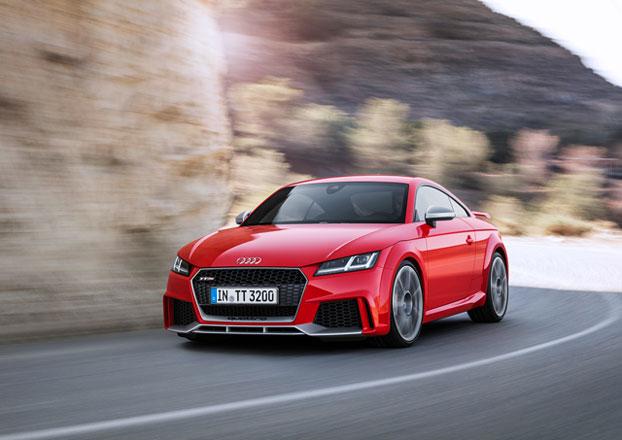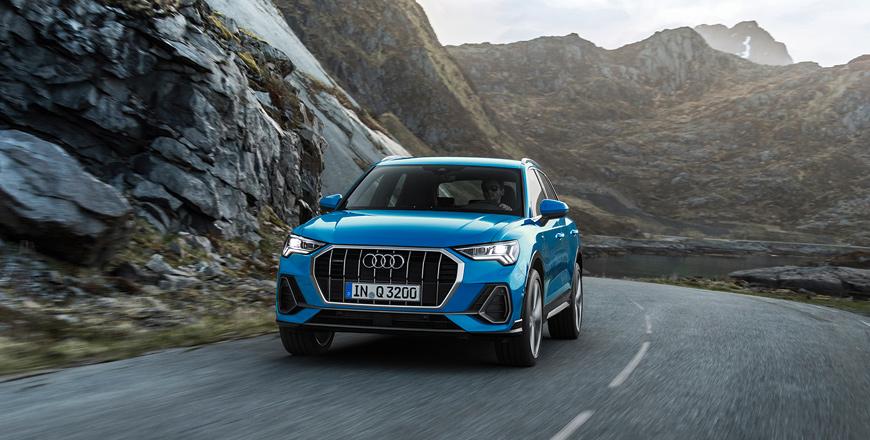You are here
Audi TT RS: Prodigious pint-sized brute
By Ghaith Madadha - Feb 20,2018 - Last updated at Feb 20,2018

Photos courtesy of Audi
A pint-sized brute with prodigious punch, adamant road-holding and feral performance, the compact Audi TT RS is the most powerful and capable iteration of Ingolstadt’s diminutive 2+2 sports coupe to date. An upstart banging vigorously on the supercar club’s doors, the TT RS is based on Audi-Volkswagen’s compact and versatile mass production MQB platform.
Nevertheless, it virtually gate crashes on far more exclusive cars, and offers better daily drive practicality, efficiency and manoeuvrability, and a potentially more reliable and less worrisome ownership experience than many exotic prima donnas.
Aggressive evolution
Still a moderately popular sight on Jordanian roads, the original Bauhaus-influenced TT first arrived 20 years ago and has informed Audi design since. A seminal design moment for Audi, the original TT’s arced roofline, uncomplicated lines, geometric curves and clean aesthetic have evolved and are immediately identifiable in the contemporary third generation TT circa 2014. Launched globally in 2016, arriving in the Middle East last year and nominated for the Middle East Car of The Year awards, the Audi Sport division TT RS is expected to be available in Jordan either as a special order or in limited quantities.
Graduating from junior “lifestyle” coupe in first iteration to pocket rocket hot on the heels of supercars, the TT has evolved into a more assertive design for its third iteration, and is distinctly more aggressive in range-topping RS guise. With its brushed aluminium style frame and honeycomb hexagonal grille, the TT RS also receives similarly metallic side mirrors and sharp lower front lip, bigger higher-set rear spoiler, dual oval tailpipes, rear diffuser, and broader more pronounced sills and side intakes and gills.
Fiery five-pots
Resembling a miniaturised version of Audi’s fully-fledged mid-engine R8 supercar in appearance, the front-engine TT RS may not quite challenge it for desirability, performance or ultimate handling, but is not as far behind in performance and ability as one might imagine. Powered by a uprated incarnation of Audi’s mighty direct injection 2.5-litre 5-cylinder engine turbocharged to 2.35-bar pressure, the TT RS develops a beguiling 394BHP at 5850-7000rpm and 354lb/ft at 1700-5850rpm through a finger snap-swift shifting 7-speed automated dual clutch gearbox with escalating response and paddle-shift manual mode settings.
With tenacious four wheel-drive traction clawing at the tarmac and a quick-spooling turbocharged engine, the 1440kg TT RS rockets responsively from standstill to 100k/h in just 3.7-seconds and, with optional speed de-restriction, onto 280km/h, yet returns moderate 8.4l/100km combined cycle fuel efficiency.
With rasping, growling and distinctly burbling 5-pot acoustics, the TT RS pulls cleanly and meaningfully from low-end to haughty redline. Muscularly effortless through its wide and abundant mid-range, the TT RS overtakes with brisk confidence, while power piles on with a seemingly berserker rage and urgency as revs reach its power plateau.
Agility and commitment
Riding on a front-drive derived transverse engine four-wheel-drive platform, the TT RS is however engineered with a slight rear-drive bias, which with its short wheelbase and wide track, translates into agile and sure-footed handling. Turning into a corner with crisp immediacy, stubbornly effective road-holding and superbly taut and firmly flat body control, the TT RS is a sharper and more focused tool than other MQB-based model.
Considerably more resilient to understeer and oversteer, the TT RS also turns on the proverbial dime through corners, with quick, weighty and exact — if somewhat clinical — steering.
Germanic is its motorway stability, refinement and planted ride, the TT RS’ real talents however lie in how it manages to seemingly unwind a series of corners with its nimble agility and unwavering commitment and grip.
Its tremendous road-holding comes courtesy of its Quattro four-wheel-drive which reallocates power front-to-rear and — with limited slip differential — side-to-side along the rear axle to find traction and translate power to forward motion on low-traction surfaces. Firmly damped and sprung, the TT RS rides with a buttoned down road-hugging quality, and is tautly settled on rebound and resilient to dive, lean and squat.
Dense yet practical packaging
Driven in Dubai on optional 255/30ZR20 tyres, the TT RS was firm, smooth and absorbent enough on most roads, with only jagged sudden speed bumps inconveniencing its comfort. However, for rougher and lumpier Jordanian roads, one would expect the standard 245/35ZR19 to be more suitable and forgiving. Densely packed with plenty of hardware in a small package, the TT RS is however well-packaged and accommodating in front, with generous headroom and good sightlines even for taller and larger drivers. Its hatchback boot is surprisingly accommodating, while small occasional use rear seats, absent from its Porsche Cayman and Mercedes SLC-Class rivals offer additional utility.
Decked with quality leathers, metals and plastics, and soft textures aplenty, the TT RS’ cabin has a pronounced sporting flavour including a well-adjustable and chunky flat-bottom steering wheel, supportive sports seats and a highly adjustable driving position with well-centred steering, pedals and instrument panel.
Design is uncluttered and fresh, with a stubby gear lever, three round centre vents, user-friendly and advanced infotainment system, and Audi’s configurable Virtual Cockpit digital instrument panel. Well-equipped with standard and optional features, the TT RS is available with lane assistance safety system, reversing sensors and camera, and optional ceramic disc brakes.
TECHNICAL SPECIFICATIONS
- Engine: 2.5-litre, transverse, turbocharged 5-cylinders
- Bore x stroke: 82.5 x 92.8mm
- Compression ratio: 10:1
- Boost pressure: 2.35 Bar
- Valve-train: 20-valve, DOHC, direct injection, continuously variable valve timing
- Gearbox: 7-speed automated dual clutch, four-wheel-drive, electronic multi-plate clutch and differential lock
- Ratios: 1st 3.563; 2nd 2.526; 3rd 1.679; 4th 1.022; 5th 0.788; 6th 0.761; 7th 0.635; R 2.789
- Final drive, 1st, 4th, 5th, R/2nd, 3rd, 6th, 7th: 4.059:1/3.450:1
- Power, BHP (PS) [kW]: 394.5 (400) [294] @5,850-7,000rpm
- Specific power: 159BHP/litre
- Power-to-weight: 274BHP/tonne (unladen)
- Torque, lb/ft (Nm): 354 (480) @1,700-5,850rpm
- Specific torque: 193.5Nm/litre
- Torque-to-weight: 333Nm/tonne (unladen)
- 0-100km/h: 3.7-seconds
- Top speed: 280km/h
- Fuel consumption, urban/extra-urban/combined: 11.4/6.6/8.4-litres/100km
- CO2 emissions, combined: 192g/km
- Fuel capacity: 55-litres
- Length: 4,191mm
- Width: 1,832mm
- Height: 1,344mm
- Wheelbase: 2,505mm
- Track, F/R: 1,564/1,543mm
- Overhangs, F/R: 893/793mm
- Headroom, F/R: 993/858mm
- Shoulder room, F: 1,362mm
- Loading height: 803mm
- Aerodynamic drag co-efficient: 0.32
- Luggage volume, min/max: 305/712-litres
- Unladen/kerb weight: 1440/1515kg
- Steering: Electromechanical variable assistance rack & pinion
- Turning Circle: 10.96-metres
- Suspension, F/R: MacPherson struts/multi-link, anti-roll bars
- Brakes, F/R: Perforated, ventilated discs, 370 x 34mm/310 x 22mm
- Brake callipers, F/R: 8-/1-piston
- Tyres: 255/30ZR20
Related Articles
First introduced in 1998 as a small fun coupe both celebrated and dismissed for its design-led approach, the third generation Audi TT now bo
Giving way to hot hatchbacks, larger premium super saloons and estates, and performance SUVs and crossovers, the small fast saloon was forme
The second smallest of the German manufacturer’s line of various size SUVs and crossovers to suit most tastes, the Audi Q3 is a compact and














